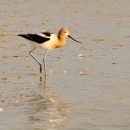Seasons of Wildlife
Waterfowl- Dabbling Ducks
Dabbling ducks feed by tipping down to reach aquatic plants and invertebrates below the surface. They take flight by springing into the air. Common dabbling ducks on Northwest Montana Wetland Management District Flathead County include: American Wigeon, Cinnamon Teal, Mallard, Northern Pintail and Northern Shoveler.
Waterfowl- Diving Ducks
Diving ducks dive and swim underwater to feed. They need a running start on the water to get airborne. Common diving ducks on Northwest Montana Wetland Management District Flathead County include: Canvasback, Common Merganser, Lesser Scaup, Redhead, Ring-necked Duck, and Ruddy Duck.
Waterfowl- Sea Ducks
Sea Ducks are diving ducks that spend part of their life in coastal waters. Common sea ducks on Northwest Montana Wetland Management District Flathead County include: Barrow’s and Common Goldeneye, and Bufflehead.
Swans and Geese
Swans and geese are the largest members of the waterfowl group of birds. Swans eat mostly plant materials both on land and in the water. Geese also eat mostly plant materials but they spend more time on land grazing on grasses and other plants. Both swans and geese mate for life. Common swans and geese on Northwest Montana Wetland Management District Flathead County include: Canada Geese, Trumpeter and Tundra Swans.
Waterbirds
The waterbird group includes bird species dependent on aquatic habitats during parts of their life cycle. Waterbirds can be found in the open oceans, along the coast in both fresh and saltwaters, wading in fresh or brackish inland waters, or hiding in inland fresh water marshes. Common waterbirds on Northwest Montana Wetland Management District Flathead County include: Sandhill Cranes, Sora, American Coot, Pied-billed, Horned, Eared, and Red-necked Grebes, Great Blue Herons, Common Loons, and Ring-billed Gulls.
Shorebirds
Shorebirds are typically found along shorelines of rivers and lakes. They are commonly characterized by long bills, legs and toes. Common shorebirds on Northwest Montana Wetland Management District Flathead County include: Killdeer, American Avocets, Black-necked Stilts, Wilson’s Phalaropes, Wilson’s Snipe, Spotted Sandpipers and Greater and Lesser Yellowlegs.
Grassland and Shrubland Birds
Upland habitat on WPAs supports a wide array of grassland and shrubland birds. Common birds on Northwest Montana Wetland Management District Flathead County include: Savannah, Song, Vesper and Clay-Colored Sparrows, Western Meadowlark, Eastern Kingbird, Marsh Wren, Ruby-crowned Kinglet, Yellow Warbler, Common Yellowthroat, Calliope and Rufous Hummingbirds, Brewer’s Yellow-headed and Redwing Blackbirds, Evening Grosbeak, Tree, Violet Green and Barn Swallows, Common Raven, Black-capped Chickadee, Black-billed Magpie, Northern Flicker, Brown-headed Cowbird, Mourning Dove, Red-naped Sapsucker, Downy and Harry Woodpeckers, and American Goldfinch.
Eagles, Owls and Hawks
Raptors are birds of prey who feed off of other animals. Eagles, owls, hawks and falcons are all part of this group of excellent hunters. These birds use their binocular vision and keen hearing in order to detect their prey. They also have large powerful grasping feet with razor sharp talons for catching their prey. Most raptors also have large, hooked bills that can tear their prey apart to eat. Some raptors are diurnal or daytime species (hawks, falcons and eagles) and some are nocturnal or nighttime species (owls). Common raptors on Northwest Montana Wetland Management District Flathead County include: Bald and Golden Eagles, Short-eared and Great Horned Owls, Red-tailed and Rough-legged Hawks, Northern Harriers, Northern Goshawks, American Kestrel, Merlin, and Prairie Falcon.
Featured Species
Northwest Montana Wetland Management District Flathead County is part of the 5% of WPAs not found in the prairie wetlands of the Dakotas, Minnesota and eastern Montana. Western Montana WPAs serve an important role for migrating birds. Wetlands are scarce in the drier Intermountain West which means they play an even more important role for millions of water-dependent birds that migrate through or nest in western Montana.

